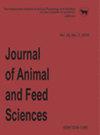Brain-derived neurotrophic factor (BDNF) affects somatotrophic axis activity in sheep
IF 1.5
4区 农林科学
Q3 AGRICULTURE, DAIRY & ANIMAL SCIENCE
引用次数: 5
Abstract
Brain-derived neurotrophic factor (BDNF), a growth protein factor belonging to the neurotrophin peptide family, participates in mechanisms that promote differentiation and survival of developing neurons. Moreover, BDNF is involved in processes related to neuronal neuroplasticity and neuroprotective mechanisms, such as the stimulation of nerve growth and the formation of synaptic connections between nerve cells (Peiris et al., 2004). Brain-derived neurotrophic factor mRNA is located in several areas of the brain; for example, in the neocortex, hippocampus, medulla oblongata and hypothalamus. In the mediobasal hypothalamus (MBH), BDNF immunoreactive material has been identified in the paraventricular (PVN), arcuate (ARC), ventromedial (VMN) or dorsomedial (DMN) nuclei, as well as in the median eminence (ME) (Unger et al., 2007; Cordeira et al., 2010). The presence of tyrosine kinase receptor isoform B (TrkB), which is a specific receptor for BDNF, ABSTRACT. Brain-derived neurotrophic factor (BDNF) is a growth protein factor belonging to the neurotrophin peptide family that is involved in the regulation of several activities of the central nervous system. However, its effects on the activity of the somatotrophic axis in ruminants have not yet been determined. The present study aimed to verify the research hypothesis, which assumed that BDNF can modulate key hormones of the somatotrophic axis in sheep. The experiment involved sexually mature Polish Merino sheep (n = 24). The animals were divided into three groups, and the following intracerebroventricular infusions were performed: control group received Ringer-Locke solution (480 μl/day), BDNF10 – BDNF at a dose of 10 μg/480 μl/day and BDNF60 – BDNF at a dose of 60 μg/480 μl/day. Blood samples were collected on days 0 and 3 of infusions. After the experiment, the animals were slaughtered and selected structures of the hypothalamus, pituitaries and plasma samples were stored for Real-Time reverse transcription-polymerase chain reaction (Real-Time RT-PCR) and radioimmunoassay analysis. It was revealed that central BDNF administration induced a dose-dependent increase in growth hormone relasing hormone (GHRH) mRNA expression in the mediobasal hypothalamus of sheep. Moreover, central BDNF administration increased growth hormone (GH) mRNA expression in the pituitary and the GH pulse amplitude, which, consequently, increased the mean GH concentration in the blood plasma. These observations suggest the up-regulation of the somatotrophic axis activity in female sheep after BDNF infusion. So, it can be stated that BDNF is involved in the modulation of key hormones co-creating the somatotrophic axis in mature sheep. Received: 27 July 2021 Revised: 19 October 2021 Accepted: 26 October 2021脑源性神经营养因子(BDNF)影响绵羊的生长营养轴活性
脑源性神经营养因子(BDNF)是一种属于神经营养素肽家族的生长蛋白因子,参与促进发育中神经元分化和存活的机制。此外,BDNF参与与神经元神经可塑性和神经保护机制相关的过程,如刺激神经生长和神经细胞之间突触连接的形成(Peiris等人,2004)。脑源性神经营养因子mRNA位于大脑的几个区域;例如,在新皮层、海马、延髓和下丘脑。在基底中下丘脑(MBH)中,BDNF免疫反应物质已在室旁核(PVN)、弓状核(ARC)、腹内侧核(VMN)或背内侧核(DMN)以及正中隆起(ME)中被鉴定(Unger等人,2007;Cordeira等人,2010)。酪氨酸激酶受体亚型B(TrkB)的存在,它是BDNF的特异性受体,摘要。脑源性神经营养因子(BDNF)是一种生长蛋白因子,属于神经营养因子肽家族,参与调节中枢神经系统的几种活动。然而,它对反刍动物体营养轴活性的影响尚未确定。本研究旨在验证BDNF可以调节绵羊体营养轴关键激素的研究假设。实验涉及性成熟的波兰美利奴羊(n=24)。将动物分为三组,进行以下脑室内输注:对照组接受Ringer Locke溶液(480μl/天),BDNF10–BDNF剂量为10μg/480μl//天,BDNF60–BDNF用量为60μg/480µl/天。在输注的第0天和第3天采集血样。实验结束后,屠宰动物,并储存选定的下丘脑、垂体结构和血浆样本,用于实时逆转录聚合酶链式反应(实时RT-PCR)和放射免疫分析。结果表明,中枢BDNF给药诱导绵羊下丘脑中基底部生长激素相关激素(GHRH)mRNA表达呈剂量依赖性增加。此外,中枢BDNF给药增加了垂体中生长激素(GH)mRNA的表达和GH脉冲幅度,从而增加了血浆中GH的平均浓度。这些观察结果表明,BDNF输注后雌性绵羊的体营养轴活性上调。因此,可以说BDNF参与了关键激素的调节,共同创造了成熟绵羊的体营养轴。接收日期:2021年7月27日修订日期:2021月19日接受日期:2021 10月26日
本文章由计算机程序翻译,如有差异,请以英文原文为准。
求助全文
约1分钟内获得全文
求助全文
来源期刊

Journal of Animal and Feed Sciences
农林科学-奶制品与动物科学
CiteScore
2.10
自引率
0.00%
发文量
42
审稿时长
3 months
期刊介绍:
Journal of Animal and Feed Sciences (JAFS, J. Anim. Feed Sci.) has been published by the Kielanowski Institute of Animal Physiology and Nutrition, Polish Academy of Sciences in Jabłonna (Poland) since 1991. It is a continuation of the Polish-language journal Roczniki Nauk Rolniczych. Seria B, Zootechniczna published by the Polish Academy of Sciences since 1969.
JAFS is an international scientific journal published quarterly, about 40 papers per year including original papers, short communications and occasionally reviews. All papers are peer-reviewed and related to basic and applied researches in the field of animal breeding and genetics, physiology of nutrition, animal feeding, feed technology and food preservation. The journal distinguishes the multidisciplinary nature of physiological and nutritional sciences and so includes papers specialized in all fields connected with animal well-being, including molecular and cell biology and the emerging area of genetics.
 求助内容:
求助内容: 应助结果提醒方式:
应助结果提醒方式:


